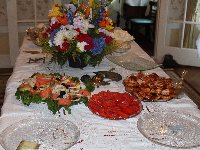
Syrian food is rich in vegetables, grains, fruit, nuts, beans and aromatic spices. The same ingredients are used in different ways in different dishes and blended into an assortment of dishes. Lemons, onion and garlic, as well as mint and parsley are used in vast quantities. Syrian bread (known as pita) is served at most meals and is used to dip into dips and salads.
In Syrian foods, presentation is everything. Individual hors d’oeuvres are stuffed with vegetables, and vegetables are stuffed with meats. Even the most basic dishes are garnished. A typical Syrian meal begins with maza, a spread of hor d’oeuvres, salads and appetizers, as well as an assortment of nuts and pickles. Main meals include meat, chicken or fish, with a vegetable, salad and rice dish. A typical Syrian meal is followed by mint tea or Turkish coffee, platters of fruit and homemade pastries filled with nuts and sweetened with sugar syrup.
Food is very much a part of Syrian Jewish culture and is heavily influenced by the topography and environment in the Middle East. The preparation of certain foods at certain times of the year or special meals cooked in preparation for the Sabbath were a woman’s contribution to conveying Sephardic Jewish culture.
Syrian foods are heavily dependent on fresh vegetables and fruits; thus Syrian Jews are particularly choosy about their purchases. Many fresh fruit and vegetable grocers have gone out of business when their fare was not of the caliber expected.
 Skip to main content
Skip to main content